Have you ever walked into a kindergarten and felt the warmth, creativity and inspiration? Do you want to know how to create your own creative kindergarten classroom? Do you know any wonderful preschool classroom decorations?
Designing preschool classroom decorations is all about finding the perfect balance. It’s about creating a space that sparks curiosity, inspires learning, and feels welcoming without overstimulating young minds. From selecting calming yet cheerful color palettes to adding playful, interactive elements, every decoration plays an important role in shaping a child’s daily learning experience.
In this guide, you’ll find practical ideas, color inspirations, and decoration themes tailored for preschool settings. From wall displays to reading corners, we’ll explore how every detail can support children’s learning and emotional well-being — without overwhelming your classroom.
لماذا تعتبر زخارف الفصول الدراسية في مرحلة ما قبل المدرسة مهمة؟
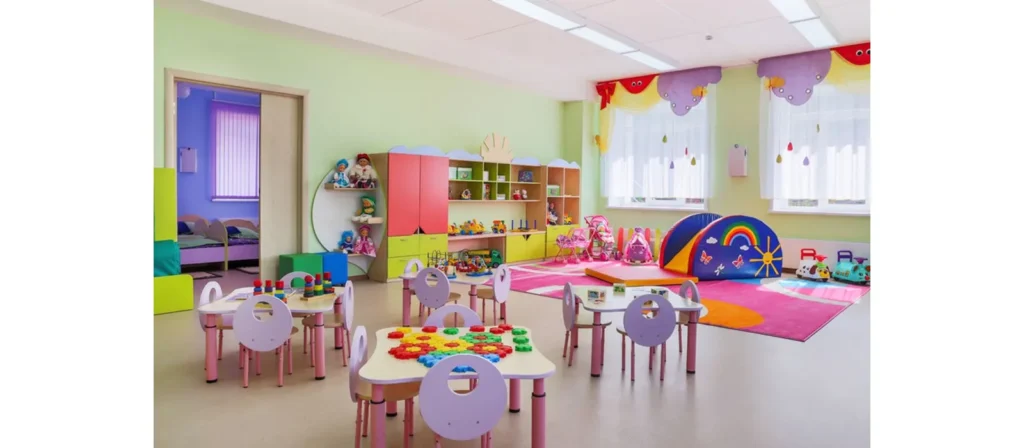
التأثير النفسي لتصميم الفصول الدراسية
Research suggests that colors, spatial organization, and visual stimuli significantly impact children’s learning abilities and emotional well-being. Bright, warm colors can energize children, while soft pastels promote calmness and focus. Defined spaces within the classroom provide structure and help children transition smoothly between activities.
تشجيع التعلم من خلال التحفيز البصري
Children in their early years learn best through sensory experiences. Thoughtfully designed preschool classroom decorations, including educational posters, themed displays, and hands-on interactive elements, help reinforce learning concepts and encourage exploration.
تعزيز النمو الاجتماعي والعاطفي
A well-decorated classroom supports not just academics but also social and emotional development. Displays that celebrate student achievements, diversity, and teamwork foster a sense of pride and inclusivity among children.
15 Preschool Classroom Decoration Ideas
Below are the 15 core ideas with practical guidance. Some entries include short project plans, supply lists, or implementation steps. You don’t need to implement every idea at once; pick the ones that match your program’s goals, space, and children’s needs.
1. Create a Calming Environment
One of the first and most critical decorating decisions is setting the emotional tone of a classroom. Preschoolers thrive when the environment feels safe, predictable, and warm. Instead of overwhelming every wall with bold colors or every ceiling with dangling mobiles, aim for visual balance. Research indicates that classrooms with excessive visual stimulation can actually hinder attention and learning: in one study, children in heavily decorated rooms were off‑task significantly more than in sparsely decorated spaces.
- Choose a restrained palette. Pick two base tones and a bright accent used sparingly. For example: warm cream, sage green, and sunflower yellow accents. Use these across rugs, baskets, and bulletin borders.
- Designate quiet zones. Use a soft rug and low canopy to define a reading/calm area. Keep that area free from high‑contrast posters or flashing lights.
- Limit visual clutter. Opt for a few meaningful displays instead of covering every wall. Leave “negative space” — blank wall sections that reduce visual noise and let children rest their eyes.
- Lighting choices. Use diffused light — sheer curtains for windows and a soft lamp in the calm corner. Avoid direct harsh fluorescent lighting over the entire gathering area.
2. Decorate a Reading Area
A classroom without a dedicated reading space is like a library without shelves. Reading corners are not just functional—they’re emotional havens for preschoolers. A cozy, well-decorated reading area can promote literacy, build emotional security, and foster independent exploration.
Use soft seating like beanbags or small armchairs. Install low bookshelves so children can access books on their own. Then add thematic wall décor that matches current reading topics—jungle animals, fairy tales, outer space.
You can also include:
- Hanging mobiles with letters or characters
- Cushioned rugs with alphabet patterns
- Simple fabric canopies to create a “nook” feeling
If you have windows nearby, add light curtains to filter natural light and prevent distractions. The goal is to make this area inviting and slightly enclosed.
3. Decorate the Classroom with Kids’ Art
Displaying children’s creations increases motivation, builds identity, and makes the classroom feel like a shared community. It’s high‑impact, low‑cost décor that showcases learning processes, not just final products.
- Rotating gallery walls with framed student pieces
- A clothesline with clips to hang paintings
- Laminated drawings with each child’s name below
Make sure art is hung at the child’s eye level. You’re not just creating décor—you’re building self-esteem. It’s also a subtle classroom management tool. When children feel proud of their environment, they’re more likely to care for it.
4. Ideas for Bulletin Boards
Bulletin boards can be decorative, functional, and instructional all at once. They’re not just placeholders—they’re storytelling spaces. With thoughtful design, bulletin boards can support themes, showcase learning progress, and communicate important information.
- Monthly themes like seasons, community helpers, or holidays
- Student portfolios with writing samples or artwork
- Behavioral charts using positive reinforcement visuals
- Letter/Number of the week boards
Keep your boards interactive when possible. Add Velcro elements, flip panels, or spaces for student input. The more children can manipulate or engage with the board, the better.
Limit yourself to one or two major bulletin boards in the classroom, and keep the rest of the wall space calm and breathable.
5. Fun Birthday Displays
Celebrating birthdays in preschool is a great decorating opportunity. it builds community, acknowledges each child, and adds joy. But it’s important to balance fun with focus and inclusivity. But instead of generic, store-bought birthday posters, make your display personal and meaningful.
- A “birthday train” with each child’s photo in a train car
- A cupcake wall with children’s names and birthday dates
- A simple timeline with month headers and child-made icons
- Use a consistent format and color scheme to create continuity.
6. Design a Visual Schedule Board
Young children thrive on routine. When they can see what’s coming next, they feel more in control—and less anxious. A visual schedule board shows the daily routine in pictures and words. You can attach visuals with Velcro or magnets to move them around.
Images with short word labels are suitable for emerging readers and older children. Post the schedule near the door or gathering area for easy reference each morning. Choose a location near a transition (e.g., entryway, carpeted area) and at children’s eye level.
7. Decorate with a Welcome Banner
The first thing children see when they enter the classroom matters. A welcome banner can immediately establish a positive tone for the day.
Avoid overly flashy, generic “WELCOME!” signs. Instead:
- Use multi-language greetings to reflect classroom diversity
- Incorporate student photos or self-portraits
- Use themes like rainbows, trees, or sunshine to make it cheerful
You can involve children in making the banner. This increases their connection to the space and helps transition them into the learning environment from the very first step through the door.
8. Decorate the Classroom Door
The classroom door is an everyday canvas. Use it to reflect your classroom identity, themes, or even seasonal topics. With thoughtful decoration, it can become an extension of your classroom identity and a daily point of engagement.
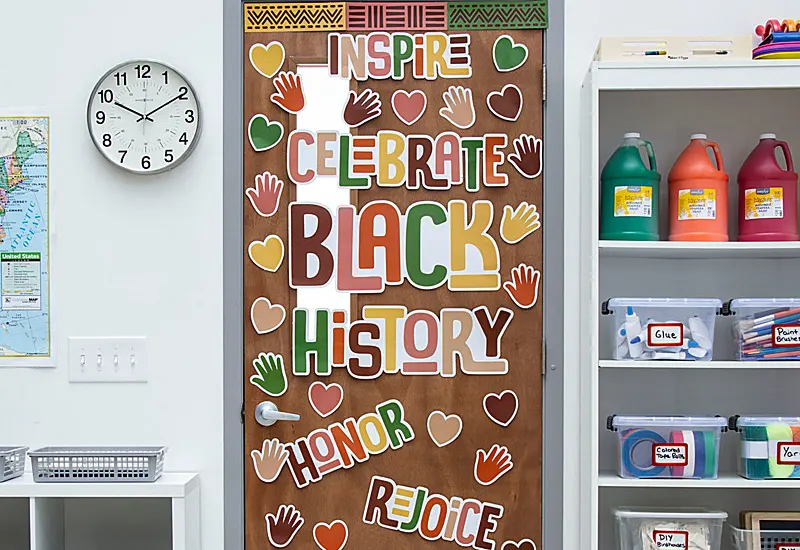
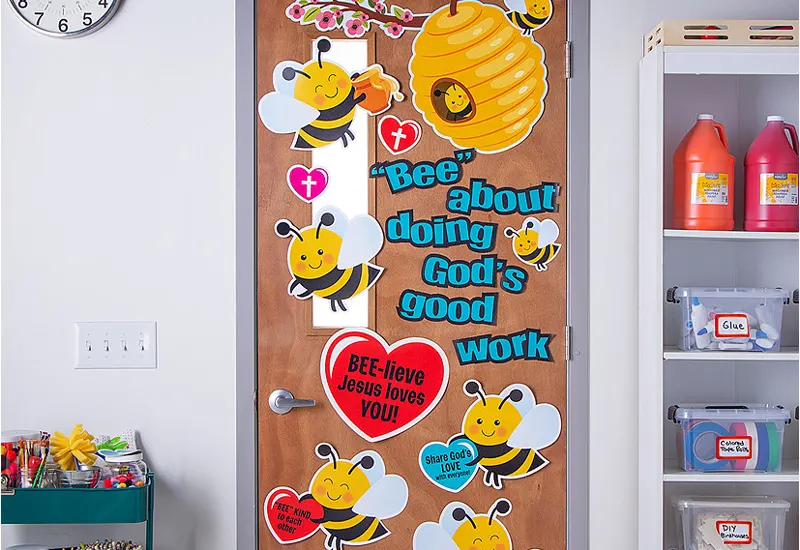
Ideas include:
- A “Who’s in Our Class?” door with children’s names and pictures
- A “Reading Adventure Starts Here” design for literacy-focused classrooms
- Seasonal or thematic displays like autumn leaves or space missions
9. Decorate the Windows and Ceiling
Many preschool teachers overlook the vertical space in the classroom. But the ceiling and windows are key visual elements in a child’s world. When decorated thoughtfully, they can bring warmth and depth to the classroom atmosphere.
Try these ideas:
- Paper lanterns or hanging pom-poms in thematic colors
- Mobiles representing seasons, numbers, or classroom mascots
- Window decals of animals, weather, or shapes
Be sure to balance visibility with safety. For windows, keep visibility clear at adult eye level but add designs at child height to make it engaging for them.
10. Use Rugs and Mats to Create Learning Areas
Floor decorations aren’t always visible. They’re also functional zones. Use rugs and mats to divide space and set behavioral expectations. Choose materials that are non-slip, easy to clean, and sized correctly for your classroom layout. Always opt for neutral or primary color schemes that match the overall classroom tone—not neon chaos.
11. DIY Wall Decor
DIY wall decorations are one of the most effective ways to bring personality and heart into your preschool classroom—without sacrificing budget or originality. Unlike store-bought posters that quickly become background noise, DIY décor invites participation, creativity, and connection.
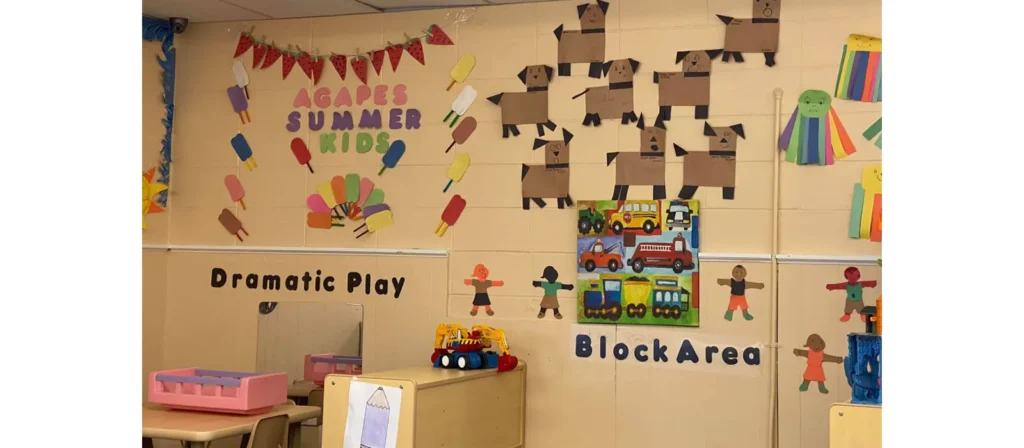
Here are DIY wall décor ideas:
- Create a “handprint tree” where each child adds their painted handprint as a leaf—then use it to track growth or seasons.
- Make a fabric or felt “learning journey” banner where children add personalized icons (e.g., “I learned to write my name,” “I counted to 20”).
- Use recycled magazine or paper scraps to create a colourful mosaic of shapes for a math wall.
- Use string and clothespins across a wall to display children’s current work.
- Have children help cut large letters or shapes for thematic walls and then allow them to place or arrange the pieces themselves.
- Laminate key visuals you use often so they last longer and can be reused year after year.
12. Creative Decorative Objects
While walls, boards, and rugs set the tone, the small decorative objects around your classroom are what give it warmth, depth, and storytelling. These elements should be intentional—not clutter—and always child-safe.
Classroom Mascots
Use a plush toy, puppet, or character figure as a “classroom mascot.” This character can sit on a shelf, participate in circle time, and even have its own name and backstory. It becomes a beloved member of the group and offers continuity.
Thematic Tabletop Displays
Create small decorative setups for the season or unit theme. For example:
- A basket of fall leaves, pinecones, and tiny pumpkins
- A globe, astronaut doll, and stars for space week
- Dinosaurs and faux fossils during a prehistoric unit
Keep these displays simple and child-accessible, using them to spark curiosity and discussion.
Repurposed Natural Materials
Use wooden bowls, stones, shells, or driftwood as both décor and manipulatives. They add texture and a sensory element to the environment, aligning well with Reggio and Montessori principles.
Family Photo Walls or Frames
A small corner with framed family photos helps create emotional security and connection. Each child can bring a family photo to display. This humanizes the room and helps children feel grounded.
Don’t overdo it—just a few key messages placed meaningfully can have a big impact.
13. Name Tags and Personalized Spaces
Personalization in the classroom helps each child feel valued and visible. At this developmental stage, children are forming a sense of identity, and seeing their name and picture on their cubby, seat, or project folder affirms their belonging in the classroom.
Name tags should be simple, clear, and easy to recognize. Ideally, they include the child’s name in large print alongside a visual cue, like a photo or a symbol. This helps children who are still developing literacy skills quickly locate their belongings. Teachers can even involve students in designing their own labels, giving them a sense of ownership and a creative opportunity to express themselves.
These personalized elements can extend beyond cubbies and tables. Mailboxes, supply bins, art drying racks, and classroom job charts can all be labeled with children’s names.
14. Music and Sound as Part of the Decor
While not visual, acoustic decorations can deeply influence the classroom atmosphere. Incorporating soft music, sound centers, or even musical instrument walls can enhance mood and support auditory learning.
Design ideas:
- A hanging bell wall where children can gently ring chimes
- A music corner with soft drums, maracas, or xylophones
- Background classical or nature soundtracks played during quiet time
Sound should be soothing, not overstimulating. Just like color and light, sound is an environmental tool that shapes behavior.
15. Reuse and Use Old Materials for Decorating
One of the most practical, sustainable, and creative decorating strategies is repurposing and reusing materials. This fosters resourcefulness, reduces cost, and often generates richer student‑centered décor.
Preschool decorating doesn’t need to strain your budget. Some of the most creative classroom spaces I’ve seen used entirely upcycled and repurposed materials.
- Turning old T-shirts into wall banners
- Using scrap fabric to create hanging flags
- Repurposing cardboard into student art canvases
- Framing sections of newspaper or old picture books
اعتبارات تزيين الفصل الدراسي لمرحلة ما قبل المدرسة
Decorating a preschool classroom may seem like a simple task, but in reality, it requires thoughtful consideration, strategic planning, and a strong understanding of child development. An effective preschool classroom should be colorful and cheerful, yes—but also functional, safe, and developmentally appropriate. Every visual element you introduce into the space should serve a purpose: to support learning, reinforce routines, build a sense of community, or encourage independence.

1. Use Bright Colors
Bright colors capture attention and create excitement. Young children are naturally drawn to vivid hues, and the right color palette can stimulate learning, reinforce themes, and differentiate classroom zones. However, the use of color should be intentional. Too much brightness everywhere can cause visual clutter and overstimulation.
2. Keep It at Eye Level
Since preschoolers spend most of their day sitting, playing, and walking close to the floor, decorations should be placed at their eye level. This helps children engage more meaningfully with visual aids, thematic displays, and instructional signage. It also fosters independence.
3. Keep Children Involved
When children help create or choose classroom decorations, they feel a sense of ownership and belonging. It fosters confidence and builds classroom community. Their contributions also reflect real learning and personal expression, making the décor more meaningful than store-bought posters.
4. Stay Organized
Young children rely heavily on structure. When decorations are messy or overdone, they blur those boundaries and confuse behavioral cues. Keeping things orderly doesn’t mean dull. It means that every visual element has a purpose, and everything has a place. Organized décor supports calmness, reduces conflict, and builds a productive learning environment where children feel secure.
5. Use Safe Materials
Safety should never be compromised in favor of aesthetics. All décor must be made from non-toxic, age-appropriate, and durable materials. Safety concerns include choking hazards, sharp edges, or flammable items. Ensuring all materials meet health and safety standards protects both children and staff, reducing risk during daily activities.
6. Keep Safety in Mind
Beyond material safety, decoration placement affects visibility, traffic flow, and emergency access. Hanging décor must be secure, exits must remain clear, and walkways must be free of tripping hazards. Designing with safety in mind prevents accidents and supports smooth classroom operations.
7. Choose the Right Furniture
Classroom decoration doesn’t start with posters and streamers—it starts with furniture. The layout, color, height, and placement of your tables, chairs, cubbies, and shelving units all play a role in how the classroom feels and functions.



- Select age‑appropriate furniture: Child‑sized tables, chairs, shelves at reachable heights.
- Consider flexible furniture: Pieces that can move easily or reconfigure support dynamic décor zones and seasonal changes.
- Furniture should serve dual purposes: For example, bookcases that display books cover‑out, or low cabinets with decorative tops to define zones and display children’s work.
- Matches the decor: Consistent finishes, clean lines, minimal patterns help décor and furniture feel unified.
- Durability and maintenance: Furniture for preschoolers must withstand active use, spills, and be easy to clean and rearrange.
أرسل لنا رسالة إذا كان لديك أي أسئلة أو اطلب عرض أسعار. سيقدم لك خبرائنا الرد خلال 48 ساعة ويساعدونك في اختيار المنتج المناسب الذي تريده.
8. Remember to Change Your Decor
Children thrive on novelty and seasonal rhythms. Updating classroom decorations throughout the year keeps the environment stimulating and relevant. Whether it’s monthly bulletin boards, seasonal themes, or rotating student artwork, a changing environment supports curiosity and engagement. It also reinforces concepts like time, transitions, and cycles. However, changes should be predictable and structured—not random. A consistent update schedule helps children anticipate change and adjust comfortably. Planning décor updates alongside curriculum themes is the most effective approach.
9. Control Your Budget
A well-decorated classroom doesn’t have to break the bank. Reusing materials, incorporating student artwork, and DIY projects can achieve meaningful, personalized décor without excessive spending. Budget-friendly choices also model sustainability and creative problem-solving for children.
How to Decorate Spaces with Different Functions?
يجب أن يحتوي الفصل الدراسي المنظم جيدًا على مساحات محددة بوضوح لمختلف الأنشطة. تساعد هذه المساحات الأطفال على فهم أماكن أداء المهام المحددة، وتسهل عليهم الانتقال بسلاسة خلال اليوم الدراسي.
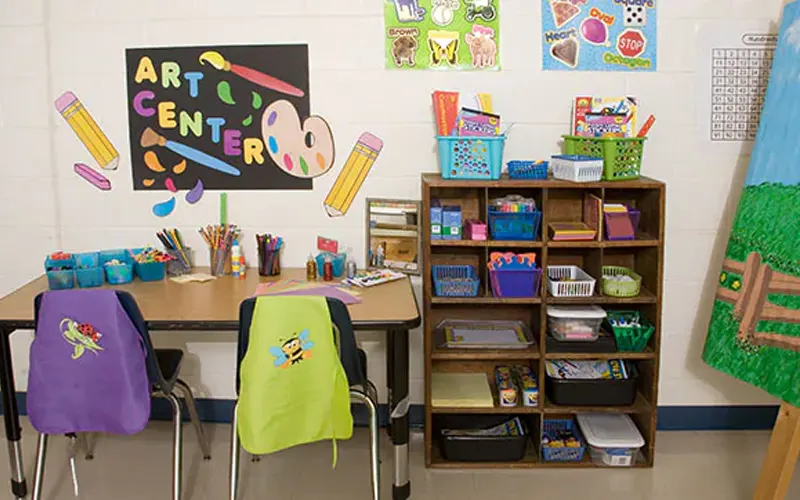
مركز الفنون لمرحلة ما قبل المدرسة
أن مركز الفنون ركنٌ أساسيٌّ لتعزيز الإبداع والتعبير عن الذات. جهّزه بموادٍ مناسبة للأطفال، مثل أقلام التلوين والطلاء ولوازم الحرف المُعاد تدويرها. استخدم شاشات عرض جدارية ملونة ورفوف تجفيف لعرض أعمال الطلاب الفنية، مما يجعل المكان مُلهمًا وعمليًا في آنٍ واحد.
مركز علوم ما قبل المدرسة
تجربة عملية مركز العلوم يُثير الفضول والاستكشاف. جهّزوا المكان بعدسات مكبرة، وصناديق حسية، وتجارب بسيطة. تُضفي ملصقات الطبيعة والكواكب وجسم الإنسان زينةً جذابةً على فصول ما قبل المدرسة، مُشجّعةً العقول الصغيرة على طرح الأسئلة والاستكشاف.
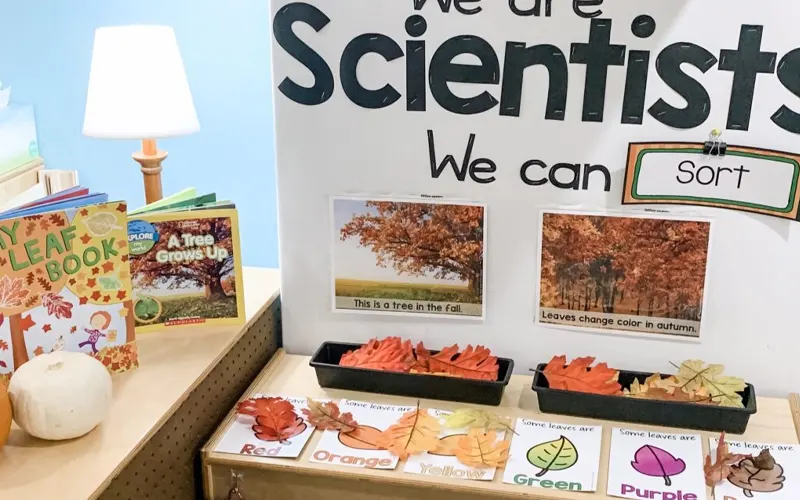
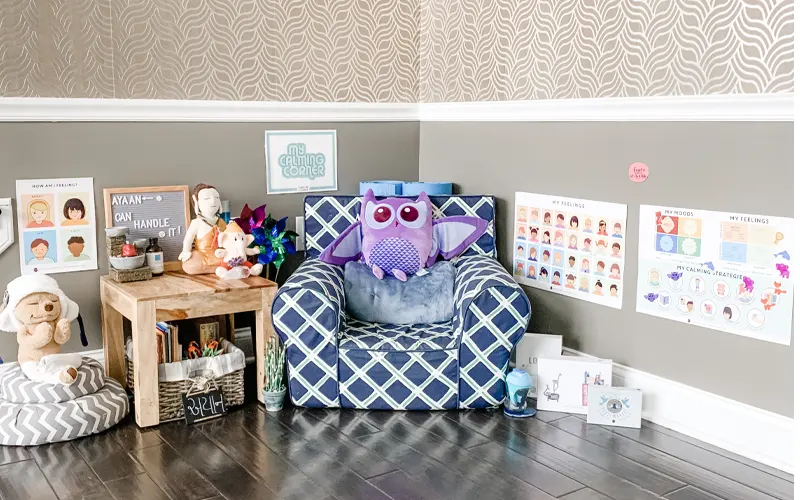
ركن التهدئة
أ ركن هادئ يساعد الأطفال على تنظيم أنفسهم وإدارة مشاعرهم. استخدموا مقاعد ناعمة، وألوانًا هادئة، وعناصر حسية مثل ألعاب التململ أو البطانيات الثقيلة. إضافة ديكورات مستوحاة من الطبيعة، مثل مظلة سماء مرصعة بالنجوم أو إضاءة خافتة، تجعل المكان أكثر هدوءًا.
ركن القراءة في الفصل الدراسي
ركن قراءة مريح يُشجّع على حبّ الكتب. رتّب رفوفًا بكتب مصورة سهلة الوصول، وأضف وسائدًا أو أكياسًا للراحة، وزيّنها بملصقات أبجدية أو ملصقات جدارية مستوحاة من القصص لخلق مساحة أدبية جذابة.
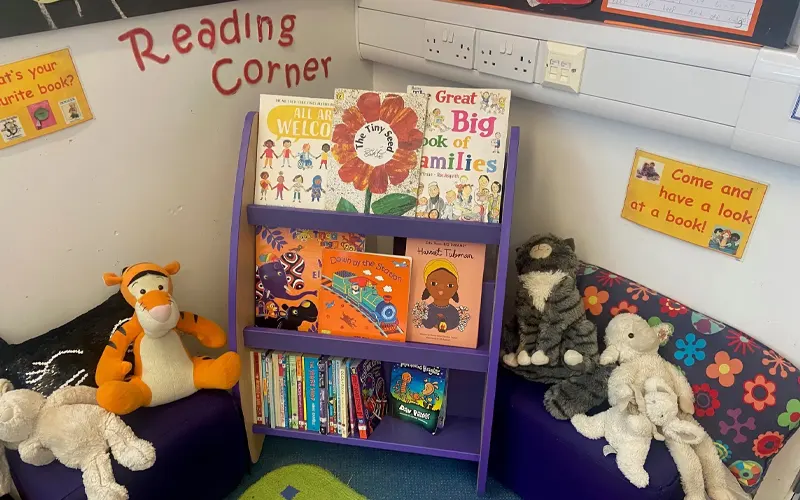
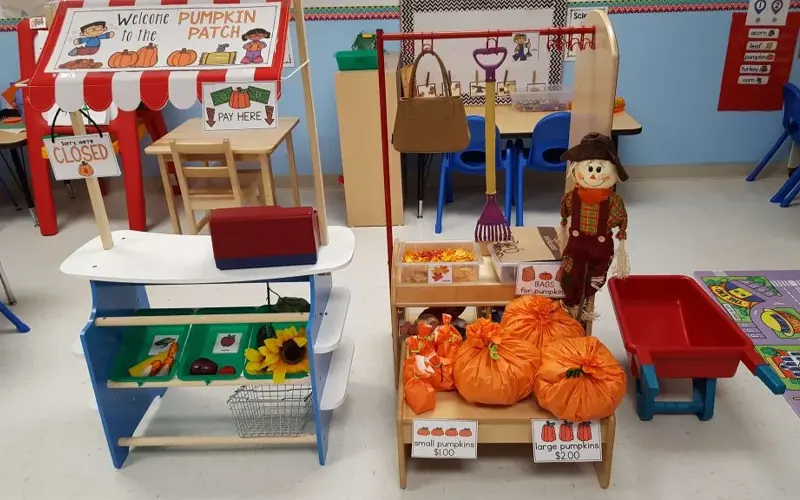
منطقة اللعب الدرامية
مسرحية درامية يُعزز المهارات الاجتماعية والإدراكية. سواءً كان مطبخًا تظاهريًا، أو متجرًا صغيرًا، أو عيادة طبيب، فإن الدعائم والخلفيات ذات الطابع الخاص تُضفي حيويةً على اللعب التخيلي. غيّر أماكن التركيب بانتظام للحفاظ على تفاعل الأطفال مع المكان.
ديكورات الفصول الدراسية لمرحلة ما قبل المدرسة الموسمية
تزيين فصول ما قبل المدرسة وفقًا للفصول يُضفي على البيئة جوًا منعشًا وجذابًا وتعليميًا. تُساعد المواضيع الموسمية الأطفال على التواصل مع الطبيعة، واستكشاف التغيرات في العالم من حولهم، والاحتفال بالمناسبات الخاصة. سواءً كانت زهورًا زاهية للربيع أو رقاقات ثلج دافئة للشتاء، تُعزز ديكورات فصول ما قبل المدرسة الموسمية أجواء التعلم وتجعل الفصل مكانًا ممتعًا للأطفال الصغار.
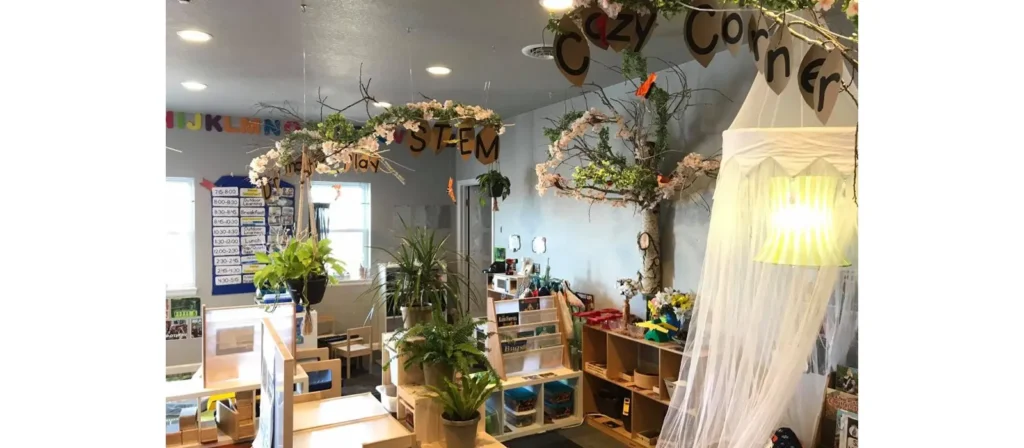
زينة فصل الربيع لمرحلة ما قبل المدرسة
الربيع هو موسم التجديد، مما يجعله الوقت المثالي لدمج موضوعات ديكور الفصول الدراسية لمرحلة ما قبل المدرسة ذات الألوان المنعشة والمستوحاة من الطبيعة.
- ديكورات الجدران:لإنشاء بيئة نابضة بالحياة، استخدم زخارف الجدران في الفصول الدراسية لمرحلة ما قبل المدرسة مثل قصاصات الفراشات، وأكاليل الزهور، واللافتات قوس قزح.
- ديكورات أبواب الفصول الدراسية:فكر في أفكار تزيين باب الفصل الدراسي لمرحلة ما قبل المدرسة، مثل باب "الحديقة المتنامية" مع الزهور الورقية وأسماء الطلاب على شكل بتلات.
- ديكورات السقف:يمكن أن يؤدي تعليق الزخارف مثل السحب الورقية وقطرات المطر وأشعة الشمس إلى جعل المكان يبدو خفيفًا وجيد التهوية.
- زوايا النشاط:إنشاء محطة زراعة حيث يمكن للأطفال زراعة نباتات صغيرة أو أعشاب، ودمج أفكار تزيين الفصل الدراسي لمرحلة ما قبل المدرسة مع موضوعات الحديقة.
- زخارف قابلة للطباعة:استخدم مواد قابلة للطباعة لتزيين الفصول الدراسية في مرحلة ما قبل المدرسة مثل ملصقات الأبجدية ذات الطابع الربيعي ومخططات التعلم القائمة على الطبيعة.
ديكورات فصول ما قبل المدرسة الصيفية
ينبغي أن تعكس ديكورات الفصول الدراسية الصيفية الدفء والمغامرة والأنشطة الخارجية الممتعة. غالبًا ما تتضمن أفكار ديكور الفصول الدراسية لمرحلة ما قبل المدرسة في الصيف مواضيع الشاطئ والمحيط والتخييم.
- ديكور الحائط:عرض أمواج المحيط والأسماك والأصداف البحرية مع ديكور الحائط لفصول ما قبل المدرسة لإنشاء عالم تحت الماء.
- ديكورات الفصول الدراسية ذات الطابع الخاص: يستخدم موضوع الفصل الدراسي لمرحلة ما قبل المدرسة ديكورات تضم كرات الشاطئ والقلاع الرملية والنظارات الشمسية لخلق جو من المرح.
- نوافذ الفصول الدراسية:أضف ملصقات الشمس الملونة أو فن بصمة اليد لتفتيح ديكورات نوافذ الفصول الدراسية لمرحلة ما قبل المدرسة.
- ديكور اصنعها بنفسك:قم بدمج ديكور الفصل الدراسي لمرحلة ما قبل المدرسة بنفسك عن طريق صناعة مراوح ورقية وطائرات ورقية ومراوح دوارة.
زينة فصل الخريف لمرحلة ما قبل المدرسة
تُضفي زينة الخريف أجواءً دافئة، وموضوعات حصاد، واحتفالات موسمية. غالبًا ما تُركز زينة الخريف لفصول ما قبل المدرسة على اليقطين وأوراق الشجر ومخلوقات الغابة.
- لوحات الحائط والإعلانات:استخدم أفكار تزيين جدران الفصل الدراسي لمرحلة ما قبل المدرسة مع أوراق الشجر المتساقطة، وفزاعات الطيور، ومشاهد الخريف المريحة.
- أبواب الفصول الدراسية:أطلق العنان لإبداعك من خلال أفكار تزيين أبواب الفصول الدراسية في فصل الخريف لمرحلة ما قبل المدرسة، مثل "حقل اليقطين" مع اسم كل طالب على اليقطين.
- ديكور معلق:يمكن أن تشتمل زخارف سقف الفصول الدراسية لمرحلة ما قبل المدرسة على أوراق الخريف والجوز والبوم.
- العناصر التفاعلية:شجرة الامتنان التي يضيف الأطفال عليها ملاحظات شكر هي فكرة رائعة لتزيين الفصل الدراسي لمرحلة ما قبل المدرسة.
زينة فصل ما قبل المدرسة في فصل الشتاء
تُضفي زخارف الشتاء جوًا تعليميًا دافئًا وساحرًا مع رقاقات الثلج والقفازات والديكورات الاحتفالية. تُضفي زخارف الشتاء على فصول ما قبل المدرسة جوًا من الإثارة والتشويق، حيث يتعلم الأطفال عن طقس الشتاء والأعياد.
- ديكورات الجدران والنوافذ:استخدم زخارف الشتاء في فصول ما قبل المدرسة مثل قصاصات الثلج، وأكاليل الثلج، والحيوانات الشتوية.
- أبواب الفصول الدراسية:تتضمن أفكار تزيين باب الفصل الدراسي في فصل الشتاء لمرحلة ما قبل المدرسة موضوع "بلاد العجائب الشتوية" مع رجال الثلج ومشهد التزلج.
- ديكور السقف:قم بتعليق رقاقات الثلج القطنية أو الأضواء الناعمة للحصول على جو احتفالي.
- المناطق الحسية:صندوق حسّي بموضوع الثلج مع ثلج صناعي وتماثيل حيوانات شتوية يعزز موضوعات تزيين الفصل الدراسي لمرحلة ما قبل المدرسة.
زينة فصول ما قبل المدرسة في العطلات
تُضفي زينة الأعياد على فصول ما قبل المدرسة جوًا احتفاليًا وممتعًا. سواءً كان عيد الهالوين، أو عيد الشكر، أو عيد الميلاد، تُساعد زينة فصول ما قبل المدرسة الأطفال على فهم التقاليد الثقافية، وتُضفي على المكان جوًا من الدفء والمرح.
زينة فصول ما قبل المدرسة لعيد الهالوين
تُضفي زينة الهالوين جوًا من الرعب المرح على الفصل الدراسي. ينبغي أن تكون زينة الهالوين في فصول ما قبل المدرسة ممتعة وغير مخيفة.

- ديكورات الجدران:استخدم زينة الفصل الدراسي لمرحلة ما قبل المدرسة، مثل الأشباح الودودة، والقرع، والخفافيش.
- أبواب الفصول الدراسية:يمكن أن تتضمن أفكار تزيين باب الفصل الدراسي لمرحلة ما قبل المدرسة موضوع "الوحش الودود" أو "حقل اليقطين".
- ديكور تفاعلي:يمكن أن تكون لوحة العد "خدعة أم حلوى" جزءًا من ديكور الفصل الدراسي لمرحلة ما قبل المدرسة مع تعزيز التعلم.
- الحرف اليدوية:شجع الأطفال على إنشاء فوانيس ورقية وشبكات عنكبوت لتزيين الفصل الدراسي.
زينة فصول ما قبل المدرسة بمناسبة عيد الشكر
تُركّز ديكورات عيد الشكر على الامتنان والحصاد والترابط. يُمكن أن تشمل ديكورات الفصول الدراسية لمرحلة ما قبل المدرسة لعيد الشكر ألوانًا خريفية دافئة وعناصر ذات طابع خاص.

- لوحات الحائط والإعلانات:"شجرة الامتنان" ذات الأوراق التي يصنعها الطلاب للتعبير عن الامتنان تشكل ديكورًا جذابًا لجدار الفصل الدراسي لمرحلة ما قبل المدرسة.
- ديكورات أبواب الفصول الدراسية:زينة باب الفصل الدراسي لمرحلة ما قبل المدرسة على شكل ديك رومي مع بصمات أيدي الطلاب كريش تضيف لمسة شخصية.
- زينة الطاولة:استخدم زخارف لعناصر ما قبل المدرسة في الفصول الدراسية مثل القرع الورقي، والقرنبيط، وأكاليل الخريف.
زينة عيد الميلاد في فصول ما قبل المدرسة
تُضفي زينة عيد الميلاد البهجة والدفء على بيئة ما قبل المدرسة. ويمكن أن تتميز زينة فصول ما قبل المدرسة بألوان العيد، وشخصياته الاحتفالية، وأجواءه الشتوية الدافئة.
ديكور قابل للطباعة:تضيف زخارف الفصول الدراسية لمرحلة ما قبل المدرسة القابلة للطباعة، مثل مخططات الأبجدية وملصقات الأرقام ذات الطابع الاحتفالي، لمسة تعليمية احتفالية.
ديكورات الجدران والأسقف:استخدم زينة عيد الميلاد، مثل رقاقات الثلج، وأشجار عيد الميلاد، والأضواء المتلألئة، في فصول ما قبل المدرسة.
أبواب الفصول الدراسية:تتضمن أفكار تزيين باب الفصل الدراسي لمرحلة ما قبل المدرسة موضوع "ورشة عمل سانتا" أو "بيت خبز الزنجبيل".
ركن الحرف اليدوية لعيد الميلاد:يمكن أن تتضمن أفكار تزيين الفصول الدراسية في عيد الميلاد لمرحلة ما قبل المدرسة محطة لصنع الزينة بنفسك.
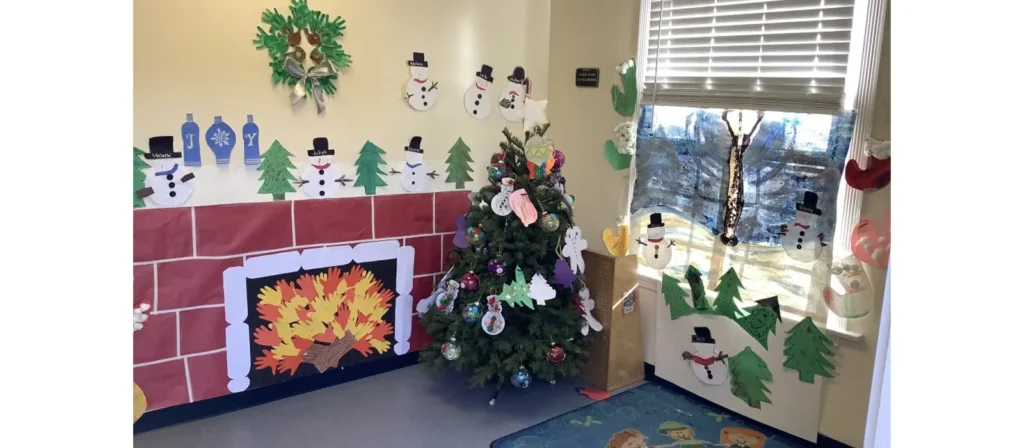
خاتمة
تلعب ديكورات فصول ما قبل المدرسة دورًا محوريًا في تشكيل تجربة التعلم لدى الأطفال الصغار. فالفصل الدراسي المُزين جيدًا يُوفر تحفيزًا بصريًا، ويشجع على التفاعل، ويعزز الإبداع. ومن خلال اختيار المواضيع بعناية، واستخدام عناصر تفاعلية، ودمج ديكورات موسمية وعطلات، يمكن للمعلمين خلق بيئة تعليمية ديناميكية وجذابة.
من لوحات الإعلانات التفاعلية إلى الزخارف المستوحاة من الطبيعة، ينبغي أن يدعم كل عنصر من عناصر الفصل الدراسي التعلم ويجعله مكانًا مُرحِّبًا وممتعًا. ينبغي أن تكون الزخارف عملية وممتعة في آنٍ واحد، لضمان شعور الأطفال بالإلهام كل يوم يدخلون فيه إلى فصول ما قبل المدرسة.
من خلال تحديث البيئة بشكل مستمر، يمكن للمعلمين إبقاء الطلاب منخرطين ومتحمسين للتعلم، مما يخلق أساسًا للفضول والإبداع مدى الحياة.




